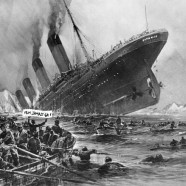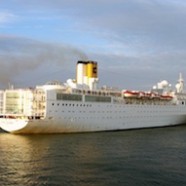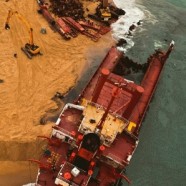A Full tank of risks in Guyana, Normandy, and in the Arctic
Drilling in Guyana- Press release # 2
Shell is leading the dance in Guyana. The offshore is going to be subjected for over a year to the harmful effects and pollutions of 4 exploratory petroleum drillings and experimental pumping. The Guyanese coast and neighboring countries are not immune to drifts of accidental oil spills. The Scientific Committee of the International Whaling Commission has highlighted the diversity of large and small cetaceans off the coast of Guyana in 2011. Manatees, leatherback sea-turtles, and thousands of migrating birds that come from the Caribbean and Brazil to reproduce on the Grand Connétable Islands are threatened by the ultra-deep drilling thanks to the Shell’s supremacy, pressure from the Guyana elect, and the weaknesses of the French governments. The story began in May 2001, with the issuance from a prefect departmental Prefect order granting an exclusive permit for oil exploration also called the Guyana Maritime license. The energy transition made a detour by the prehistoric era and it is well known that the impact on the environment does not address, far from it, all the risks due to noise, light and atmospheric pollution.
Full tank of Risks off the Coast of Guyana
Shell, the black gold ogre loiters off the coast of Guyana. The drilling vessel Stena IceMax, just passed off the coast of Cap in South Africa and is making its way towards Guyana. The first of Shell’s four new exploratory oil drillings should begin June 19th on the other side of the South Atlantic. The dossier is still not complete; the decree from Guyana’s Prefect on the preliminary dispositions for work and the prevention of marine pollutions still has not been signed. There is cause for concern and to suspend the prefects signing.
Full tank of Risks off the Coast of Guyana
Shell, the black gold ogre loiters off the coast of Guyana. The drilling vessel Stena IceMax, just passed off the coast of Cap in South Africa and is making its way towards Guyana. The first of Shell’s four new exploratory oil drillings should begin June 19th on the other side of the South Atlantic. The dossier is still not complete; the decree from Guyana’s Prefect on the preliminary dispositions for work and the prevention of marine pollutions still has not been signed. There is cause for concern and to suspend the prefects signing.
For a Packaged Deal onboard Concordia I
Costa Concordia – Press release # 4
Tomorrow, Saturday May 26, in Marseille, will occur the maiden voyage of the MSC Divina, aka the new mass destruction weapon of the cruise industry. It means destruction of the pleasure of being at sea, of the environment, landscapes, and of human dignity. These tourist transports are like huge containers of tools for globalization and sociological mass phenomena. Sophia Loren will be the godmother of the MSC Divina. This is perhaps her best character, but not her best film.
Stop the Gigantics !
Costa Concordia – Press release n°3
Giglio
The Gigantic was the name with which White Star Line christened its 3rd liner. The Gigantic was even bigger than the Titanic.
After the Titanic sank, the company changed its communications strategy, launching the Gigantic under the name Britannic in 1914.
Nightmare in the North Sea
At 12:15 on March 25th an incident occurred at the Elgin-Franklin offshore platform complex situated approximately 240km east of Aberdeen. It is estimated that a total 200,000 cubic meters of gas per day, is spreading into the atmosphere and directly impacting 4.8 km2 of the marine environment. According to Total they are currently unable to assess the exact quantity of gas which is leaking into the environment, they have stated that the size of the sheen is reducing.
The cloud of hot gas which reaches temperatures of 190°C around the Elgin platform is explosive in and around the zone. It is within this explosive zone that the emergency team will have to intervene to inject the well with mud to try to cut off the gas. No responsible employer would ever take such a high risk with their workers lives. Even if the depth of water from the well head is only 93 meters it could take up to 6 months to drill relief wells in extremely dangerous situation of explosive gas. Maybe an option could be to sit back and do nothing as has been done before, since 1990 methane gas has continued to leak into the North Sea from a drilling exploration expedition that went wrong at bloc 22/4b. The industry and the British authorities concluded that sealing the well could result in uncontrolled release from new leakage paths in the fragile geologic formation.
Somewhere between ‘Are you ready?” and “shhh!…The child’s asleep”.
The maritime prefect of the Mediterranean has chosen the right option: the first. They have deployed anti-pollution measures in Corsica to counter the possible arrival of oil from the Costa Concordia wreck. Italy has yet to do the same for Sardinia and the Elba. It is noted here and there that there are recommendations on the use of dispersants. In an environment as fragile and rich in biodiversity, this toxins product is not recommended.
Faced with soothing words from several stakeholders, Robin des Bois emphasises that pollutants and floating debris in the marine sub-region encircled by Italy and France can float hundreds of kilometres.
Costa Concordia : the worst has been avoided
Gigantic ocean liners and other types of ships such as container ships have worried towing and sea salvage specialists for years. Such large vessels worried the sailor and writer Joseph Conrad a century ago. Back in May 1912, one month after the Titanic tragedy, , he imagined the horrors and doubts of a night-watchman in the future, that is to say today. “ You are at night on the bridge in charge of a 150,000 tons ship, with a motor track, organ-loft etc. with a full cargo of passengers, a full crew of 1,500 cafe waiters, two sailors and a boy and three collapsible boats (.). You perceive suddenly right ahead, and close to, something that looks like a large ice-floe. What do you do? “(1).
When Life Gives You Bremens…
The cutting out of the cargo ship is a provocation regarding every observer endowed with common sense. The photos of the demolition demonstrate that even while the wreckage has its keel in the water, the shearing continues. The images of the polluted scrap metal floating in the sea water are overwhelming. They prove that the idea men and the workers on site disregard the marine environment, underestimating the effects of the contamination of the ecosystem and of the neighbouring marine communities by micro-pollutants from lead paint and operational residue from the ship itself. This shearing phase of the ship in the waves is comparable to rinsing scrap metal in the sea.











